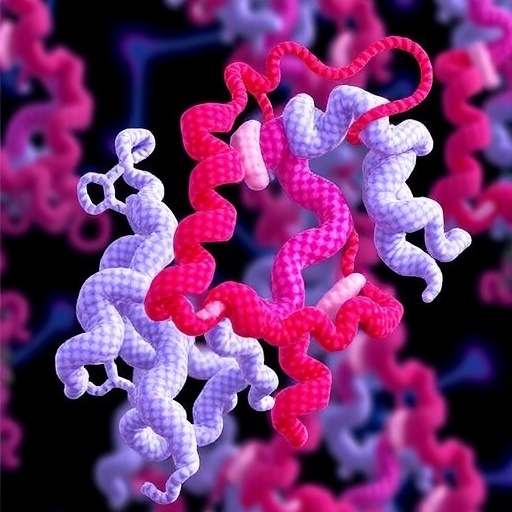In a groundbreaking study published in Cell Research, scientists at St. Jude Children’s Research Hospital have unveiled unprecedented molecular insights into the human sweet taste receptor’s mechanism of activation. Employing cutting-edge cryo-electron microscopy (cryo-EM), the research team captured the receptor’s full conformational landscape as it interacts with artificial sweeteners sucralose and advantame. This work not only fills a long-standing gap in our understanding of how sweetness is perceived at the molecular level but also lays the foundation for designing novel sweeteners that are safer and more potent.
Sweet sensation in humans begins with the activation of specialized receptor proteins located on the surface of taste bud cells. These receptors, belonging to the class C G protein–coupled receptors (GPCRs) family, consist of two subunits: TAS1R2 and TAS1R3. While the general role of these proteins in sweetness perception has been established, the precise molecular mechanics by which different sweet molecules induce receptor activation has remained obscure. Previous functional assays provided indirect clues but failed to capture the dynamic structural changes crucial to signal transduction.
To overcome this challenge, the St. Jude team applied advanced cryo-EM techniques that allow visualization of protein complexes at near-atomic resolution in multiple conformational states. This enabled researchers to observe not only the receptor’s resting and ligand-bound conformers but also an elusive intermediate referred to as the ‘loose’ state. Characterized by a partial disengagement of the so-called Venus flytrap (VFT) domains—named for their distinctive clamshell-like shape—this loose conformation appears to represent the fully activated receptor state. This discovery overturns previous assumptions derived from other class C GPCRs, where the VFT domains typically remain tightly associated upon activation.
.adsslot_MIGhl1d7YC{width:728px !important;height:90px !important;}
@media(max-width:1199px){ .adsslot_MIGhl1d7YC{width:468px !important;height:60px !important;}
}
@media(max-width:767px){ .adsslot_MIGhl1d7YC{width:320px !important;height:50px !important;}
}
ADVERTISEMENT
The elucidation of this loose state revealed that when a sweetener binds TAS1R2, a flexible loop within TAS1R2 inserts itself into the interface between TAS1R2 and TAS1R3, physically prying the VFT domains apart. This structural rearrangement triggers downstream signaling cascades that ultimately generate the perception of sweetness. Notably, this mechanism diverges markedly from that of other family members, emphasizing the unique adaptations of the sweet taste receptor to its functional demands.
Furthermore, detailed comparisons between sucralose and advantame binding revealed distinct interaction patterns despite both molecules achieving receptor activation. Sucralose, a chlorinated sucrose derivative, and advantame, a highly potent aspartame analogue, engage different residues and induce subtle but significant differences in receptor dynamics. This nuanced understanding of ligand-receptor specificity provides valuable templates for the rational design of sweeteners that harness maximal receptor activation without adverse metabolic consequences.
Co-first authors Xiao Chen and Haolan Wang highlighted the importance of capturing these transient structural snapshots. “The ability to visualize how various sweet molecules modulate the receptor’s conformational ensemble allows us to decode the molecular logic behind sweetness perception,” they noted. This integrative approach combining structural biology with functional assays underscores the multidisciplinary effort required to tackle complex sensory mechanisms.
The therapeutic and commercial implications of this discovery could be profound. With global concerns about sugar consumption and metabolic health, developing low-calorie sweeteners that reliably mimic sugar’s taste without harmful effects is a key priority. By identifying structural features that stabilize the active loose state, chemists can design molecules that maximize sweetness potency, minimize off-target effects, and perhaps even modulate receptor responses in novel ways.
Importantly, this study challenges established paradigms in GPCR biology and taste research, illustrating how protein conformational plasticity underpins sensory perception. The atypical activation mechanism of the sweet receptor may also inspire analogous investigations into related receptors governing other taste modalities, broadening our molecular map of gustatory processing.
Beyond academic insights, the researchers emphasized the potential societal benefits, including public health improvements through better sweetener design. They envision a future where structural-guided sweetener development contributes to reducing sugar-related disorders such as diabetes and obesity, enhancing both quality of life and healthcare outcomes.
Funding for this innovative research was provided by the National Institutes of Health and the American Lebanese Syrian Associated Charities, reflecting strong institutional commitment to deciphering molecular biology’s medical frontiers. The collaborative effort also involved contributions from The Rockefeller University and the University of Florida, underscoring the highly interdisciplinary nature of contemporary structural biology.
Overall, this landmark study from St. Jude Children’s Research Hospital represents a major leap forward in sensory biology. By combining the power of cryo-EM with rigorous biochemical analysis, it opens new horizons for understanding and manipulating human taste at the atomic level. As researchers continue to explore the sweet receptor’s conformational universe, the prospects of creating next-generation sweeteners that are both effective and health-conscious have never been brighter.
Subject of Research: Structural and functional analysis of the human sweet taste receptor TAS1R2/TAS1R3 and its activation mechanism by artificial sweeteners.
Article Title: Structural and functional studies uncover the mechanism behind sweet taste.
News Publication Date: August 4, 2025.
Web References:
Journal article DOI: 10.1038/s41422-025-01156-x
St. Jude Research Lab: Chia-Hsueh Lee Lab
St. Jude Structural Biology Department: Structural Biology
References: Published in Cell Research, August 3, 2025.
Image Credits: St. Jude Children’s Research Hospital.
Keywords: Structural biology, sweet taste receptor, TAS1R2, TAS1R3, GPCR, cryo-electron microscopy, sucralose, advantame, Venus flytrap domain, receptor activation, sweetness mechanism, artificial sweeteners.
Tags: advanced microscopy techniques in biochemistryartificial sweeteners researchcryo-electron microscopy in taste researchG protein-coupled receptors in tastehuman sweet taste perceptionmolecular insights into sweetnessnovel sweetener designreceptor activation mechanismssignal transduction in taste budsstructural biology of taste receptorssweet taste receptor mechanismTAS1R2 and TAS1R3 proteins





